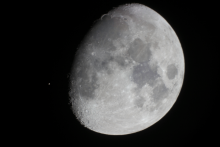Listen to today's episode of StarDate on the web the same day it airs in high-quality streaming audio without any extra ads or announcements. Choose a $8 one-month pass, or listen every day for a year for just $30.
You are here
Moon and Aldebaran
Quite a few stars that are visible to the unaided eye are like previews of coming attractions: They show us what will happen to the Sun in several billion years.
Perhaps the prime example is Aldebaran, the bright orange eye of the bull. It rises below the Moon late tonight, and follows the Moon across the sky.
Aldebaran has moved past the prime of life, so the nuclear reactions in its core have settled into a new mode. That’s made the star puff up to become a giant. So even though it’s only a little more massive than the Sun, it’s more than 40 times wider, and hundreds of times brighter.
In another few hundred million years, Aldebaran’s nuclear reactions will shut down. Aldebaran will expel its outer layers into space, creating an expanding cloud of gas and dust. The tiny, dead core will be extremely hot. Its radiation will set the surrounding material aglow, creating a colorful planetary nebula. It’ll shine for tens of thousands of years, until its material gets too thinly spread.
The Sun will reach its giant phase in several billion years. It, too, will then kick its outer layers into space. Astronomers aren’t quite sure if its dead core will be hot and bright enough to light up that material. So the Sun might produce a planetary nebula, or it might die in obscurity — simply fading into the long cosmic night.
We’ll talk about the Moon and another bright star in the bull tomorrow.
Script by Damond Benningfield



